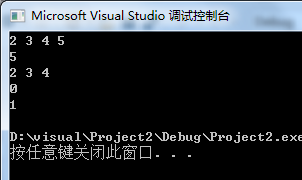1 #include<iostream> 2 #include<cstdlib> 3 #include<cstdio> 4 #define Max 50 5 #define OK 1 6 using namespace std; 7 typedef int ElemType; 8 typedef struct Stack //顺序栈的定义 9 { 10 ElemType *elem; 11 int top; 12 int capactiy; 13 }TStack,TNode; 14 15 int StackInit(TStack &s)//顺序栈的初始化 16 { 17 s.elem =(ElemType*)malloc(sizeof(ElemType) * Max); 18 if (!s.elem) 19 exit(-1); 20 s.top = 0; 21 s.capactiy = Max; 22 return 0; 23 } 24 25 void StackDestory(TStack& s)//销毁栈 26 { 27 if (!s.elem) 28 return; 29 free(s.elem); 30 s.elem = nullptr; 31 s.capactiy = 0; 32 s.top = 0; 33 } 34 35 void StackClear(TStack& s)//清空栈 36 { 37 s.top = 0; 38 } 39 40 bool StackEmpty(TStack* s)//顺序栈是否为空 41 { 42 return s->top == 0; 43 } 44 45 46 bool StackPush(TStack* s, ElemType e)//顺序栈入栈 47 { 48 s->elem[s->top++] = e; 49 return true; 50 } 51 52 bool StackPop(TStack* s)///顺序栈出栈 53 { 54 if (StackEmpty(s)||s->top == 0) 55 { 56 return false; 57 } 58 else 59 { 60 --s->top; 61 return true; 62 } 63 } 64 65 ElemType StackTop(TStack s)//顺序栈栈顶元素查询 66 { 67 return s.elem[--s.top]; 68 } 69 70 void StackShow(TStack s)//顺序栈的遍历 71 { 72 for (int i = 0; i < s.top; ++i) 73 { 74 cout << s.elem[i] << " "; 75 } 76 } 77 78 int main() { 79 TStack s ; 80 StackInit(s); 81 StackPush(&s, 2); 82 StackPush(&s, 3); 83 StackPush(&s, 4); 84 StackPush(&s, 5); 85 StackShow(s); 86 cout << endl; 87 cout << StackTop(s) << endl; 88 StackPop(&s); 89 StackShow(s); 90 cout << endl; 91 cout << StackEmpty(&s) << endl; 92 StackClear(s); 93 cout << StackEmpty(&s) << endl; 94 StackDestory(s); 95 return 0; 96 97 }
